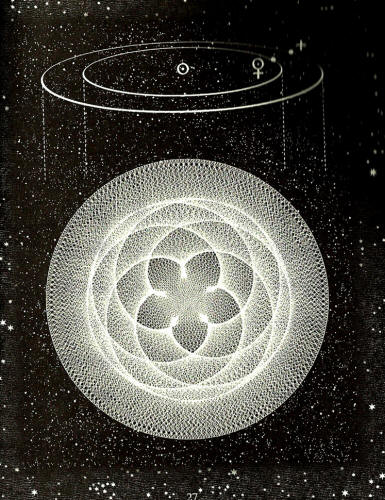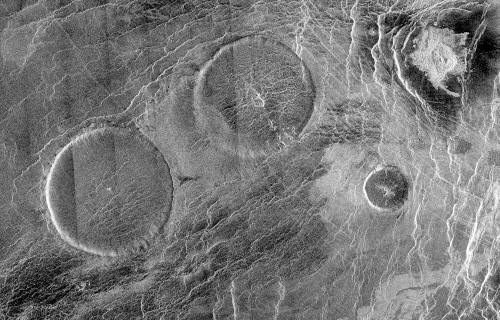|

by Stephen Smith
June 3, 2012
from
Thunderbolts Website

Venus passed
in front of the Sun on June 8, 2004.
Credit: Dan Lazzlo
Venus will transit the Sun on June 5, 2012.
Venus and Earth describe a unique orbital configuration with respect
to the Sun. The resonance between the two planets is readily
apparent when a plot (below image) of their movements is made over
the course of eight years.
Every couple of centuries, the two planets are in close enough
alignment that Venus crosses the face of the Sun twice in eight
years.
Between that pair of crossings, there is a gap of 121.5
years, then two transits in eight years, then a gap of 105.5 years,
then two transits, then a gap of 121.5 years, and so on.

Why this odd time interval?
Beginning with a transit alignment, as Venus and Earth orbit the
Sun, Venus laps Earth in its orbit after 1.6 Earth years, or 2.6
Venusian years. The fifth time that Venus catches up with Earth,
after eight years, they are back at their starting point again.
The
reason there is no transit every eight years is that the orbit of
Venus is inclined to the plane of the ecliptic, taking it slightly
above or below a line-of-sight with Earth.
After five Venus-Earth conjunctions, they are also slightly
clockwise from their starting positions. It takes 105.5 and 121.5
years for them to regress to their eight year transit pairs and
shift from June to December. In 2117, Venus will perform during
early December.
Thus, Venus is in near resonance with Earth. In order for an exact
orbital resonance to exist, Venus would have to revolve in 243.16
days, but its actual period is 243.01 days. This close alignment
suggests that it might be moving out of a resonant pattern that once
was more precise.
One factor besides gravity that might contribute to its face-to-face
dance with Earth is that Venus has a long ion tail that extends
outward for more than 45 million kilometers. During inferior
conjunction, that electrically charged structure can interact with
our magnetosphere. What if that electrical connection was much
stronger in the past?
Venus is evidently a young planet, since it retains a dense, hot
atmosphere. It also retains some of the cometary characteristics
that were probably visible to ancient civilizations.
Electric Universe theorist Wal
Thornhill writes:
“Venus, with its cometary tail, is
evidently still discharging strongly today after a recent
cometary past noted globally by ancient witnesses. Venus was
described variously as a ‘hairy star’ or ‘bearded star’ and a
stupendous prodigy in the sky.
Today, Venus’ comet tail operates in
the dark discharge mode and is invisible. It can only be
detected by magnetometers and charged particle detectors.”
Venus is supposed to have condensed
out of the same primordial cloud as the rest of the planets in the
Solar System billions of years ago.
Most planetary scientists agree that it
has been as it is for at least 300 million years. That means the
surface of Venus has been subjected to chemical erosion for hundreds
of millions of years.
Why is there no sign of any significant erosion?
The
Russian Venera landing craft
discovered that the surface of Venus (below image) is
bare rock, with a little debris
inside the cracks. This is a significant anomaly for which no one
has offered a theory.

If its entire surface has been renovated
in the last 300 million years, what caused that to happen?
Once, perhaps as little as 5000 years ago, the planets were seen as
veritable gods, with tremendous powers and chaotic aspects. Those
godlike luminaries cast violent energies upon each other and upon
Earth: boiling seas, melting mountain ranges, raising sky high
tornadoes of fire, and hurling lightning bolts sufficient to
vaporize any human work.
The planet-gods did not revolve in the stately orbits we see today.
Instead, they encroached on each other,
looming large and then retreating, only to rush together in conflict
again. During those encounters, Venus and Earth exchanged gigantic
outbursts of electric discharge. In those bolts of interplanetary
lightning they formed an electromagnetic bond. It was probably then
that the orbital resonance that both planets share came into
existence.
As time passes, the intimate relationship once shared by Gaea and
Aphrodite is beginning to fade.
The long ion tail of Venus that
continues to brush Earth with its faint electric tickle indicates
that it is still in a state of discharge as it slowly regains
equilibrium with the Solar System’s overall balance. The past
appearance of Venus as a terrifying comet with fire-like tendrils
and monstrous features has been detailed elsewhere in these pages.
For now, let it be said that the goddess
is sleeping, and in her slumber we are drifting apart.
|



